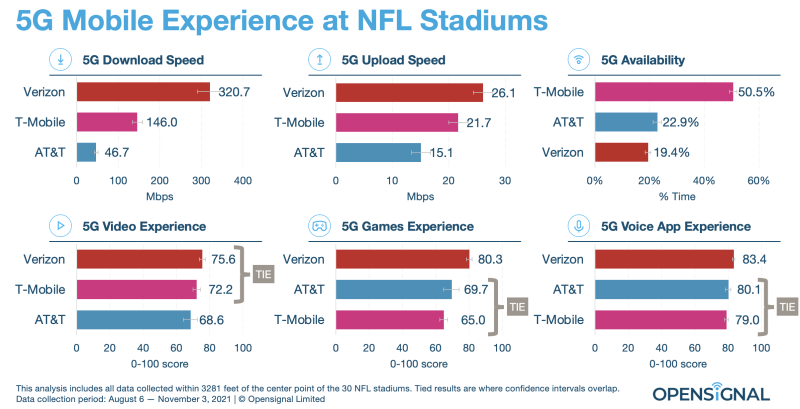Verizon’s play to deploy high-band millimeter wave spectrum for 5G in places like sports venues that attract a lot of people is paying off, according to new analysis from Opensignal.
The test and measurement company took a look at the mobile experience in and around 30 NFL stadiums in the U.S. for 90 days starting with the first preseason NFL game on August 6. Verizon came away with top marks for 5G upload and download speeds, as well experience across video, games and voice apps.
Millimeter wave spectrum has its shortcomings when it comes to coverage with short range signals that can be easily blocked, but with much larger channel sizes comes more capacity – part of the reason Verizon is using it (called 5G Ultra Wideband) in dense urban areas and venues where the network needs to handle a lot of traffic and users.
According to ESPN, the Dallas Cowboys have had the highest NFL attendance in 2021 – averaging 80,875 attendees per game. Washington was at the lower end and still averaged 62,069 attendees for 10 games.
With greater use of mmWave at NFL stadiums, Opensignal reported users on Verizon had average 5G download speeds that were twice as fast as T-Mobile and almost seven times faster than AT&T – at 320.7 Mbps, 146 Mbps, and 46.7 Mbps, respectively. Uploads were also faster in an environment where users are likely to post or share things like videos and picture. 5G users on Verizon saw upload speeds around 26.1 Mbps, versus T-Mobile at 21.7 Mbps and AT&T at 15.1 Mbps.
RELATED: Verizon in a millimeter wave groove, CTO Malady says
Verizon expects to have a total of over 30,000 mmWave sites by the end of the year compared to just 2,000 sites two years ago.
The latest Opensignal analysis recorded results for the overall mobile experience across 3G, 4G, and 5G at the stadiums, where Verizon’s mmWave boost could be seen again.
Incorporating all network technologies, Verizon users averaged around 46.0 Mbps download and 15.7 Mbps upload. The download speed was a statistical tie with T-Mobile and AT&T users, but significantly slower than Verizon’s 5G users. T-Mobile 5G users also saw a big bump of almost 100 Mbps faster, compared to average download speeds of 49 Mbps when 3G and 4G were included.
One 5G metric where Verizon didn’t perform best was availability – where users connected to 5G 19.4% of the time compared to AT&T at 22.9%. Both were well behind first-place T-Mobile, which recorded 50.5% 5G availability in the NFL stadium testing.
For users 5G experience Verizon scored highest among the three carriers for games and voice apps and tied with T-Mobile for video experience.

Stadium focus
Verizon leading the pack on 5G mobile experience at NFL stadiums follows on a 10-year 5G technology deal inked with the league this fall and mmWave deployments at 25 of the 30 locations as of September.
The technology deal with the NFL is focused on 5G use cases but isn’t strictly tied to mmWave. In stadiums Verizon has said it will use low-band, C-band (when available), and mmWave for 5G coverage.
RELATED: Verizon strikes 10-year, 5G technology deal with NFL
Fan experiences are one focus in terms of 5G use cases, such as an app created earlier this year that lets fans watch the game from up to seven simultaneous, different camera angles. Verizon also has deals with 18 NFL teams.
For Opensignal’s report, the company said it observed only limited use of mmWave 5G by AT&T and T-Mobile users in and around stadiums.
AT&T, which dubs service with mmWave "5G+", is also targeting high-traffic areas for high-band spectrum including major airport hubs in the U.S. Venues and arenas are also on the 5G+ list, where the carrier says it has mmWave at eight NFL stadiums. Still, AT&T didn’t land in the top spot for any of Opensignal’s 5G scores.
RELATED: T-Mobile turns on 2.5 GHz, 39 GHz ahead of Super Bowl LV
Like Verizon, AT&T has used dynamic spectrum sharing technology to help deploy its nationwide 5G service, which testing has shown delivers similar performance to 4G. T-Mobile’s mid-band focus with 2.5 GHz spectrum has shown significant speed improvements in many markets, but for the in-stadium experience from Opensignal it still came second to Verizon.
T-Mobile hasn’t put much emphasis on mmWave but did have low-, mid-, and high-band spectrum deployed at the Raymond James stadium ahead of the 2021 Super Bowl in Tampa. Verizon invested around $80 million in network upgrades in the Tampa Bay area while AT&T laid out around $75 million ahead of Super Bowl LV.
All three carriers delivered peak 5G speeds above 1 Gbps at the 2021 football championship, where fan attendance was still limited and carrier aggregation played a role in performance.

